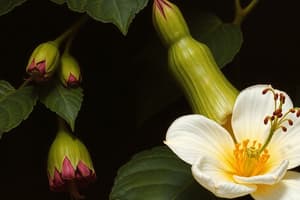Podcast
Questions and Answers
What is the main function of genetic incompatibility in self-incompatibility mechanisms?
What is the main function of genetic incompatibility in self-incompatibility mechanisms?
- To prevent pollen germination on the stigma
- To allow self-pollination
- To recognize and reject self-pollen (correct)
- To prevent pollen growth
During fruit formation, what happens to the ovary?
During fruit formation, what happens to the ovary?
- It grows and matures into a fruit (correct)
- It transforms into a seed
- It stays the same
- It degenerates
What is the primary function of the endosperm?
What is the primary function of the endosperm?
- To induce embryogenesis
- To protect the embryo
- To provide nutrients to the embryo (correct)
- To regulate embryo development
What is the term for the formation of the root, stem, and leaf primordia during embryo development?
What is the term for the formation of the root, stem, and leaf primordia during embryo development?
Which of the following is an example of abiotic pollination?
Which of the following is an example of abiotic pollination?
During fertilization, what is the function of the pollen tube?
During fertilization, what is the function of the pollen tube?
What is the result of the fertilization of the central cell nucleus?
What is the result of the fertilization of the central cell nucleus?
What is the term for the fusion of sperm nuclei with the egg nucleus and central cell nucleus?
What is the term for the fusion of sperm nuclei with the egg nucleus and central cell nucleus?
Study Notes
Sexual Reproduction in Flowering Plants
Self-Incompatibility Mechanisms
- Self-incompatibility: the inability of a flower to fertilize itself with its own pollen
- Mechanisms to prevent self-fertilization:
- Genetic incompatibility: genes that control pollen growth and pistil recognition prevent self-pollination
- Physical barriers: structures in the flower that prevent self-pollination (e.g., stamen and pistil arrangement)
- Chemical barriers: chemical signals that prevent self-pollen from germinating or growing on the stigma
Fruit and Seed Formation
- Fruit formation:
- Ovary development: after fertilization, the ovary grows and matures into a fruit
- Pericarp differentiation: the ovary wall differentiates into exocarp, mesocarp, and endocarp
- Seed formation:
- Embryo development: the zygote develops into an embryo
- Endosperm development: the fertilized central cell develops into the endosperm, providing nutrients to the embryo
Embryo Development
- Stages of embryo development:
- Zygote formation: fusion of sperm and egg nuclei
- Embryo formation: series of cell divisions and differentiation
- Organogenesis: formation of root, stem, and leaf primordia
- Embryo structure:
- Radicle (primary root)
- Hypocotyl (stem)
- Cotyledon (seed leaf)
Pollination
- Types of pollination:
- Self-pollination: pollination within the same flower
- Cross-pollination: pollination between different flowers
- Agents of pollination:
- Biotic agents: insects, birds, bats, and other animals
- Abiotic agents: wind, water, and gravity
Fertilization
- Process of fertilization:
- Pollen germination: pollen grain grows a pollen tube
- Sperm delivery: sperm nuclei are released into the pollen tube
- Fertilization: sperm nuclei fuse with the egg nucleus and central cell nucleus
- Double fertilization:
- Fertilization of the egg nucleus: forms the zygote
- Fertilization of the central cell nucleus: forms the endosperm
Sexual Reproduction in Flowering Plants
Self-Incompatibility Mechanisms
- Self-incompatibility prevents a flower from fertilizing itself with its own pollen
- Genetic incompatibility prevents self-pollination through genes controlling pollen growth and pistil recognition
- Physical barriers, such as stamen and pistil arrangement, prevent self-pollination
- Chemical barriers, such as chemical signals, prevent self-pollen from germinating or growing on the stigma
Fruit and Seed Formation
- Fruit formation occurs after fertilization, where the ovary grows and matures
- Ovary wall differentiates into exocarp, mesocarp, and endocarp
- Seed formation involves embryo development from the zygote
- Endosperm development provides nutrients to the embryo, formed from the fertilized central cell
Embryo Development
- Embryo development involves three stages: zygote formation, embryo formation, and organogenesis
- The radicle develops into the primary root
- The hypocotyl develops into the stem
- The cotyledon develops into the seed leaf
Pollination
- Self-pollination occurs within the same flower
- Cross-pollination occurs between different flowers
- Biotic agents, such as insects, birds, and bats, facilitate pollination
- Abiotic agents, such as wind, water, and gravity, also facilitate pollination
Fertilization
- Fertilization involves pollen germination, sperm delivery, and fertilization of the egg nucleus and central cell nucleus
- Double fertilization results in the formation of the zygote and endosperm
- The zygote develops into the embryo, while the endosperm provides nutrients to the embryo
Studying That Suits You
Use AI to generate personalized quizzes and flashcards to suit your learning preferences.
Description
This quiz covers the self-incompatibility mechanisms in flowering plants, including genetic, physical, and chemical barriers to prevent self-fertilization.




